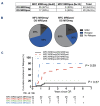Quantification of measurable residual disease using duplex sequencing in adults with acute myeloid leukemia
- PMID: 37534515
- PMCID: PMC10828764
- DOI: 10.3324/haematol.2023.283520
Quantification of measurable residual disease using duplex sequencing in adults with acute myeloid leukemia
Abstract
The presence of measurable residual disease (MRD) is strongly associated with treatment outcomes in acute myeloid leukemia (AML). Despite the correlation with clinical outcomes, MRD assessment has yet to be standardized or routinely incorporated into clinical trials and discrepancies have been observed between different techniques for MRD assessment. In 62 patients with AML, aged 18-60 years, in first complete remission after intensive induction therapy on the randomized phase III SWOG-S0106 clinical trial (clinicaltrials gov. Identifier: NCT00085709), MRD detection by centralized, high-quality multiparametric flow cytometry was compared with a 29-gene panel utilizing duplex sequencing (DS), an ultrasensitive next-generation sequencing method that generates double-stranded consensus sequences to reduce false positive errors. MRD as defined by DS was observed in 22 (35%) patients and was strongly associated with higher rates of relapse (68% vs. 13%; hazard ratio [HR] =8.8; 95% confidence interval [CI]: 3.2-24.5; P<0.001) and decreased survival (32% vs. 82%; HR=5.6; 95% CI: 2.3-13.8; P<0.001) at 5 years. DS MRD strongly outperformed multiparametric flow cytometry MRD, which was observed in ten (16%) patients and marginally associated with higher rates of relapse (50% vs. 30%; HR=2.4; 95% CI: 0.9-6.7; P=0.087) and decreased survival (40% vs. 68%; HR=2.5; 95% CI: 1.0-6.3; P=0.059) at 5 years. Furthermore, the prognostic significance of DS MRD status at the time of remission for subsequent relapse was similar on both randomized arms of the trial. These findings suggest that next-generation sequencing-based AML MRD testing is a powerful tool that could be developed for use in patient management and for early anti-leukemic treatment assessment in clinical trials.
Figures





Update of
-
Quantification of measurable residual disease using duplex sequencing in adults with acute myeloid leukemia.medRxiv [Preprint]. 2023 Mar 27:2023.03.26.23287367. doi: 10.1101/2023.03.26.23287367. medRxiv. 2023. Update in: Haematologica. 2024 Feb 01;109(2):401-410. doi: 10.3324/haematol.2023.283520. PMID: 37034683 Free PMC article. Updated. Preprint.
References
-
- Siegel RL, Miller KD, Fuchs HE, Jemal A. Cancer statistics, 2022. CA Cancer J Clin. 2022;72(1):7-33. - PubMed
-
- Dohner H, Wei AH, Appelbaum FR, et al. . Diagnosis and management of AML in adults: 2022 recommendations from an international expert panel on behalf of the ELN. Blood. 2022;140(12):1345-1377. - PubMed
Publication types
MeSH terms
Associated data
Grants and funding
LinkOut - more resources
Full Text Sources
Medical

